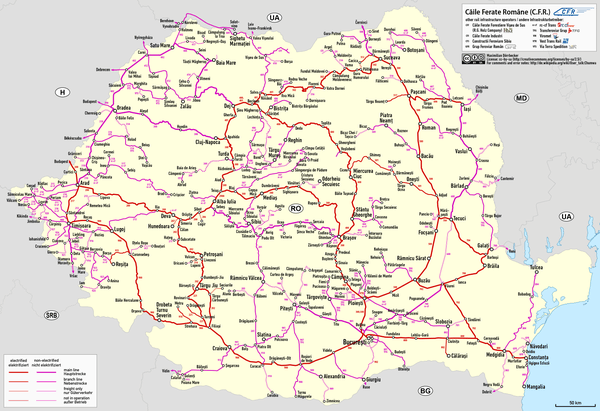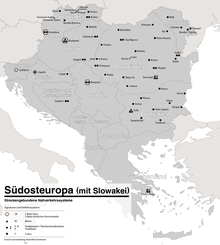Rail transport in Romania
The first railway in the Kingdom of Romania opened in 1869 and linked Bucharest and Giurgiu. The first railway on current Romanian territory opened in 1854, between Oraviţa and Baziaş in Banat, however that region was under the administration of the Austrian Empire at the time.

Since then, the Romanian railway network has been significantly expanded, and is now the fourth largest in Europe by total track length, comprising 22,298 km (13,855 mi).[1] Of these, some 8,585 km are electrified. The route length is 10,788 km.[2] Romania's railway system is inadequately-connected and one of the least durable railway systems globally.[3][4][5][6]
Romania is a member of the International Union of Railways (UIC). The UIC Country Code for Romania is 53.
Operators
The network used to be operated by Căile Ferate Române, the state railway company, but since 1998, a number of private companies have begun operations in passenger and/or freight transport.
- Regiotrans
- Grup Feroviar Român
- Servtrans
- Softrans
- Transferoviar Grup
- Unifertrans
CFR's rail freight division became CFR Marfă.

Rail links with adjacent countries
- Same gauge:
- Hungary – Multiple crossings (from North to South - Carei, Valea lui Mihai, Episcopia Bihor, Salonta, Curtici. Multiple daily passenger frequencies to Budapest and beyond (only to Gyor, Mosonmagyarovar, Hegyeshalom and Vienna for the moment) from Bucharest and from many cities within Transylvania (No voltage issues, both railroad systems electrified at 25 kV, 50 Hz AC (electrified crossing at Curtici/Lokoshaza only).
- Serbia – crossings at Jimbolia and Stamora Moraviţa. As of March 2020, no passenger rail transport from Bucharest to Belgrade via Timișoara and Vrsac. No voltage issues (crossings are not electrified).
- Bulgaria – crossings at Calafat, Giurgiu and Negru Vodă. Daily passenger service to Sofia and beyond (Athens and Istanbul) from Bucharest. No voltage issues (currently no electrified crossings, Calafat-Vidin crossing electrification is planned, same voltage, 25 kV, 50 Hz AC.
- Ukraine – Dual gauge crossing at Halmeu. No voltage issues (crossing is not electrified). Currently freight only. Dual gauge line enables standard gauge connections with Hungary and Slovakia through Chop.
- Break-of-gauge:
- Ukraine – Break-of-gauge 1,435 mm (4 ft 8 1⁄2 in)/1,520 mm (4 ft 11 27⁄32 in). Crossings at Vicşani, Valea Vişeului and Câmpulung-la-Tisa (including bogie conversion systems). Dual gauge (4 rail) track exists between Tereseva (Ukraine)/Câmpulung-la-Tisa - Sighetu Marmaţiei - Valea Vişeului, going back into Ukraine. Ukrainian trains (both freight and passenger services) occasionally use this route without stopping within Romania. International passenger services exists between Bucharest and Kiev (and onwards to Moscow) via Vicşani (operated by CFR, with UZ and RZD cars) and between Sighetu Marmaţiei and Teresva (operated by UZ). No voltage issues (crossings are not electrified).
- Moldova – Break-of-gauge 1,435 mm (4 ft 8 1⁄2 in)/1,520 mm (4 ft 11 27⁄32 in). Crossings and bogie changers exist at Ungheni (Moldova) and Galaţi-Reni. No voltage issues (None of the tracks of the Moldovan Railways are electrified). Daily passenger service to Chişinău from Bucharest. Multiple daily services from Iaşi.
References
- "Reteaua feroviara" (in Romanian). cfr.to. Archived from the original on 2009-06-08. Retrieved 2009-09-06.
- Secretariat of the European Parliament, Directorates-General, Romania's general transport master plan and rail system, retrieved on 17 December 2018. Archived at the Wayback machine "It comprises more than 1,000 stations, almost 200 tunnels and around 6,800 bridges. It is also in an advanced state of disrepair due to a chronic lack of maintenance: most of the track-related assets are on their last legs...According to the draft General Transport Master Plan about 65% of the track, 80% of the turnouts, 85% of the overhead catenary, 66% of the embankments and 40% of the bridges would require renewal. According to the Ministry of Transport 70% of rolling stock is outdated."
- Duta, Luminita. Computer-Based Decision Support for Railroad Transportation Systems: an Investment Case Study, Research Gate, retrieved on 17 December 2018. Archived at the wayback machine. "After 1989, Romania inherited one of the largest, very dense, and frequently-utilized railway networks in Europe, which has, at the same time, a relatively outdated and partially worn-out infrastructure. This situation, combined with the economic decline that Romania faced in the 1990s due to its transition to a market economy, resulted in CFR entering in a period of noticeable relative decline. In the early 2000s, CFR started on a comprehensive modernisation program with a view to improving its quality of services and image."
- Barbu, Paul. Romania ranks last in the EU in terms of railway quality, Romania Business Review, retrieved on 9 June 2019. Archived at the wayback machine. "Romania ranks on the last place among the European Union member state in terms of railway infrastructure quality, according to Octavian Udrişte, honorary president of Club Feroviar. ‘We are all trying to convince the authorities to support the railroad, because we are in the last place in Europe. Everybody says it, and the scoreboard published by DG MOVE (European Commission’s Directorate General for Transport) ranks 28th on all the analyzed transport systems –rail, road, naval, air, and public transport– with 30 criteria, and points: we are on the last place. With rail infrastructure we have won two seats, we are 26th, because Malta and Cyprus have no railways,’ Udrişte said. ‘I do have to remind you that in 30 years we did not electrify a kilometre of railway, that the pace of modernisation is slow, that at this rhythm only for Corridor IV we it still takes about 15 years, and for the entire TEN-T Comprehensive network, the Rhine-Danube network, almost 5,500 kilometres, takes nearly 200 years,’ he estimated."
- Newsroom. Featured - “Railway reform”: Destroy half of the national railroad network and fire 10,000 people, Romania Business Review, retrieved on 9 June 2019. Archived at the wayback machine. "Romania’s Government issued a memorandum regarding 'methods of increasing efficiency in the country’s railway system'. The document represents a necessity for the Transport Master Plan which has already been approved by the Executive. The memo includes drastic measures such as eliminating several routes spanning 4,000 km and reducing the national rail-network to just 6.200 km. Among the routes that could be closed down there is Bucuresti-Oltenita, Galati-Barlad and Iasi-Botosani, leaving tens of communes and villages isolated.."
See also
| Wikimedia Commons has media related to Rail transport in Romania. |
- Transport in Romania
- Căile Ferate Române
- Grup Feroviar Roman
- Regiotrans
- International Railway Systems